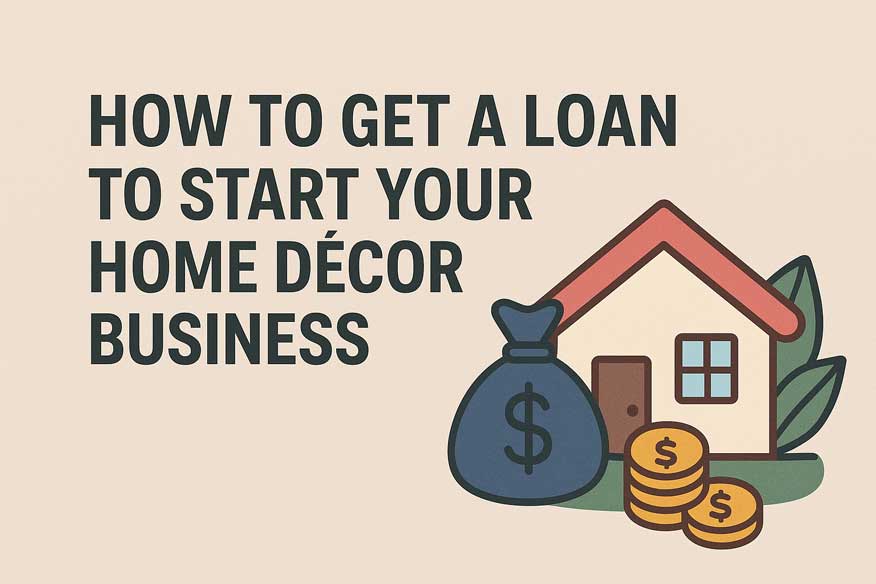
The home décor industry has been booming in recent years, thanks to rising interest in interior design, online décor shopping, and DIY home improvement trends. If you have a passion for creating beautiful living spaces, starting a home décor business can be both profitable and fulfilling. However, like any startup, it requires capital for inventory, tools, marketing, and sometimes even a showroom or office space.
If you don’t have enough savings to cover the initial costs, a loan can be the perfect solution to launch and grow your home décor business. Below is a step-by-step guide on how to secure financing.
1. Understand Your Funding Needs
Before applying for a loan, determine how much money you need and what you’ll use it for. Common startup expenses include:
- Inventory (furniture, fabrics, lighting, wall art, etc.)
- Office/showroom rent or renovation
- Tools and design software
- Marketing and branding (website, social media, advertising)
- Staff salaries (if hiring sales or design assistants)
Having a clear breakdown will help you decide the right type of loan and convince lenders that you’ve done your homework.
2. Create a Solid Business Plan
Lenders want to see that your business is well thought out and profitable. A business plan should include:
- Executive Summary – Overview of your business idea.
- Market Analysis – Trends in the home décor industry and your target customers.
- Products/Services – Will you sell furniture, décor accessories, or offer interior design services?
- Marketing Strategy – How you plan to reach and attract customers.
- Financial Projections – Expected income, expenses, and profitability over 3–5 years.
A strong business plan increases your chances of loan approval.
3. Explore Loan Options
Different types of loans are available for small businesses. Here are the most relevant ones for a home décor startup:
a) Small Business Loans (Bank Loans)
- Traditional banks offer business loans with relatively low interest rates.
- Requirements: good credit score, collateral, and a strong business plan.
- Best for: Entrepreneurs with established credit and assets.
b) Microloans
- Small loans (usually under $50,000) offered by nonprofit organizations, microfinance institutions, or government agencies.
- Easier to qualify for compared to bank loans.
- Best for: Startups that don’t need huge capital.
c) Government-Backed Loans (SBA Loans in the U.S.)
- The Small Business Administration (SBA) partners with lenders to provide loans with low interest rates and long repayment terms.
- Requires detailed paperwork but offers favorable terms.
- Best for: Entrepreneurs with a solid plan who want flexible repayment.
d) Equipment Financing
- If you need money specifically for buying furniture, fixtures, or décor supplies, equipment loans use the purchased items as collateral.
- Best for: Businesses focused on stocking up inventory.
e) Business Lines of Credit
- Similar to a credit card: you get approved for a set amount and draw money as needed.
- Best for: Covering ongoing expenses like supplies or marketing.
f) Personal Loans
- If your business is new and lacks history, you may use a personal loan from a bank or online lender.
- Best for: Sole proprietors just starting out, but riskier since it affects personal credit.
g) Alternative Financing
- Options include peer-to-peer lending, crowdfunding, or angel investors.
- Best for: Entrepreneurs who are tech-savvy and want to avoid traditional loans.
4. Build a Good Credit Profile
Your personal and business credit scores play a huge role in loan approval. To strengthen your profile:
- Pay off existing debts.
- Correct errors in your credit report.
- Separate your personal and business finances by opening a business bank account.
- Register your business to start building business credit.
5. Gather the Required Documents
When applying for a loan, you’ll typically need:
- Business plan
- Personal and business credit reports
- Bank statements (personal & business)
- Proof of income or projected revenue
- Tax returns (personal & business, if applicable)
- Legal documents (business registration, licenses, permits)
Having these ready makes the process smoother and faster.
6. Apply for the Loan
Choose your preferred lender (bank, microfinance institution, online lender, or government-backed option) and submit your application. Make sure to:
- Double-check all documents.
- Be prepared to answer questions about your business plan.
- Negotiate loan terms if possible (interest rate, repayment period, fees).
7. Use the Loan Wisely
Once approved, it’s important to spend the money strategically:
- Invest in inventory and display pieces that align with your target customers’ tastes.
- Build an online presence (website, Instagram, Pinterest, TikTok) since home décor thrives visually.
- Reserve part of the funds for marketing campaigns and branding.
- Manage cash flow carefully to ensure timely repayment.
Tips to Increase Your Chances of Approval
- Start small – Ask for the amount you truly need, not the maximum available.
- Show industry knowledge – Lenders feel more confident if you understand home décor trends.
- Offer collateral or a guarantor – This reduces the lender’s risk.
- Consider partnerships – Bringing in an investor or co-signer may improve approval chances.
- Demonstrate cash flow potential – Show how your business will generate steady income.
Conclusion
Getting a loan to start your home décor business is possible with careful planning, the right financing option, and a strong business plan. Whether you choose a traditional bank loan, microloan, or government-backed option, the key is to prove your business’s potential and manage borrowed funds wisely.
With the right funding in place, you’ll be ready to stock up on stunning décor items, build your brand, and carve out your niche in the growing home décor industry.



